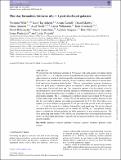Files in this item
The star formation histories of z ∼ 1 post-starburst galaxies
Item metadata
| dc.contributor.author | Wild, Vivienne | |
| dc.contributor.author | Taj Aldeen, Laith | |
| dc.contributor.author | Carnall, Adam | |
| dc.contributor.author | Maltby, David | |
| dc.contributor.author | Almaini, Omar | |
| dc.contributor.author | Werle, Ariel | |
| dc.contributor.author | Wilkinson, Aaron | |
| dc.contributor.author | Rowlands, Kate | |
| dc.contributor.author | Bolzonella, Micol | |
| dc.contributor.author | Castellano, Marco | |
| dc.contributor.author | Gargiulo, Adriana | |
| dc.contributor.author | McLure, Ross | |
| dc.contributor.author | Pentericci, Laura | |
| dc.contributor.author | Pozzetti, Lucia | |
| dc.date.accessioned | 2022-09-16T14:30:06Z | |
| dc.date.available | 2022-09-16T14:30:06Z | |
| dc.date.issued | 2020-05 | |
| dc.identifier | 266312495 | |
| dc.identifier | 3dea6efd-9833-4e1a-9ae5-fb64ee699ab7 | |
| dc.identifier | 85085387414 | |
| dc.identifier | 000535885900041 | |
| dc.identifier.citation | Wild , V , Taj Aldeen , L , Carnall , A , Maltby , D , Almaini , O , Werle , A , Wilkinson , A , Rowlands , K , Bolzonella , M , Castellano , M , Gargiulo , A , McLure , R , Pentericci , L & Pozzetti , L 2020 , ' The star formation histories of z ∼ 1 post-starburst galaxies ' , Monthly Notices of the Royal Astronomical Society , vol. 494 , no. 1 , pp. 529-548 . https://doi.org/10.1093/mnras/staa674 | en |
| dc.identifier.issn | 0035-8711 | |
| dc.identifier.other | BibCode: 2020arXiv200109154W | |
| dc.identifier.other | BibCode: 2020MNRAS.494..529W | |
| dc.identifier.uri | https://hdl.handle.net/10023/26034 | |
| dc.description | Funding: LTA acknowledges support from the Ministry of Higher Education and Scientific Research (MOHESR), Iraq. AW acknowledges financial support from the Royal Society Newton Fund (grant NAF/R1/180403, PI Natalia Vale Asari) and Fundação de à Amparo Pesquisa do Estado de São Paulo (FAPESP) process number 2019/01768-6. | en |
| dc.description.abstract | We present the star formation histories of 39 galaxies with high-quality rest-frame optical spectra at 0.5 <z <1.3 selected to have strong Balmer absorption lines and/or Balmer break, and compare to a sample of spectroscopically selected quiescent galaxies at the same redshift. Photometric selection identifies a majority of objects that have clear evidence for a recent short-lived burst of star formation within the last 1.5 Gyr, i.e. 'post-starburst' galaxies, however we show that good quality continuum spectra are required to obtain physical parameters such as burst mass fraction and burst age. Dust attenuation appears to be the primary cause for misidentification of post-starburst galaxies, leading to contamination in spectroscopic samples where only the [O II] emission line is available, as well as a small fraction of objects lost from photometric samples. The 31 confirmed post-starburst galaxies have formed 40-90 per cent of their stellar mass in the last1-1.5 Gyr. We use the derived star formation histories to find that the post-starburst galaxies are visible photometrically for 0.5-1 Gyr. This allows us to update a previous analysis to suggest that 25-50 per cent of the growth of the red sequence at z ∼ 1 could be caused by a starburst followed by rapid quenching. We use the inferred maximum historical star formation rates of several 100-1000 M⊙yr-1 and updated visibility times to confirm that sub-mm galaxies are likely progenitors of post-starburst galaxies. The short quenching time-scales of 100-200 Myr are consistent with cosmological hydrodynamic models in which rapid quenching is caused by the mechanical expulsion of gas due to an acive galactic neucleus. | |
| dc.format.extent | 2791323 | |
| dc.language.iso | eng | |
| dc.relation.ispartof | Monthly Notices of the Royal Astronomical Society | en |
| dc.subject | Galaxies: evolution | en |
| dc.subject | Galaxies: formation | en |
| dc.subject | Galaxies: starburst | en |
| dc.subject | Galaxies: stellar content | en |
| dc.subject | QB Astronomy | en |
| dc.subject | QC Physics | en |
| dc.subject | 3rd-DAS | en |
| dc.subject.lcc | QB | en |
| dc.subject.lcc | QC | en |
| dc.title | The star formation histories of z ∼ 1 post-starburst galaxies | en |
| dc.type | Journal article | en |
| dc.contributor.institution | University of St Andrews. School of Physics and Astronomy | en |
| dc.contributor.institution | University of St Andrews. University of St Andrews | en |
| dc.identifier.doi | https://doi.org/10.1093/mnras/staa674 | |
| dc.description.status | Peer reviewed | en |
| dc.identifier.url | https://arxiv.org/abs/2001.09154 | en |
| dc.identifier.url | http://adsabs.harvard.edu/abs/2020MNRAS.494..529W | en |
This item appears in the following Collection(s)
Items in the St Andrews Research Repository are protected by copyright, with all rights reserved, unless otherwise indicated.

